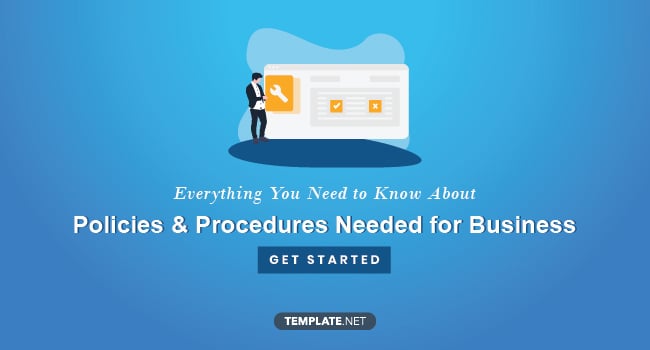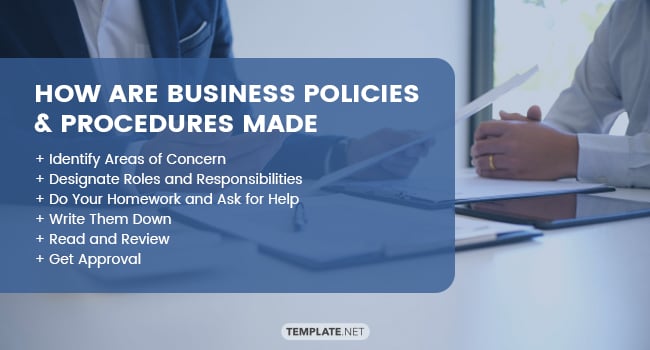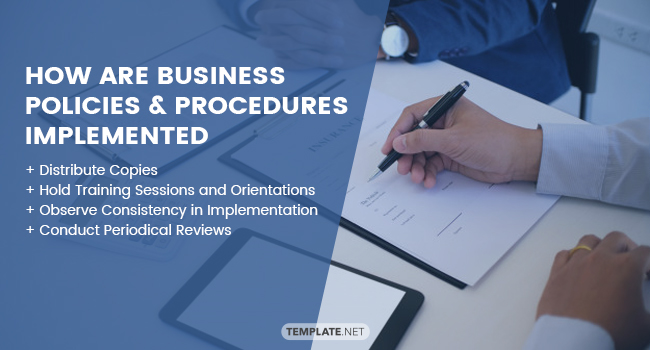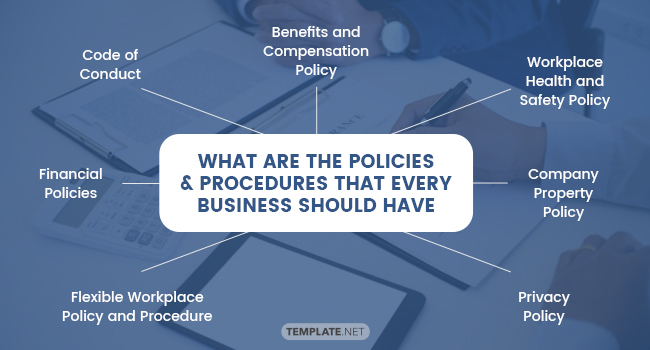List of Policies & Procedures Needed for Business
Policy-making is an often-overlooked process by those starting their own businesses. As much as some business owners shrug off its necessity, a written set of rules and regulations still has much value in any company. Oral instructions aren’t enough to instill a healthy and disciplined work environment. To help out those who lack the knowledge of policies, this post lists down everything that any establishment needs for continued business development. Not only that, but you can also expect detailed explanations for each one. Read on and you’ll never have to wonder about policy development and its implementation process ever again.

List of Policies & Procedures Needed for Business
Significance of Business Policies and Procedures
Business policies need to be written down from the get-go. While unwritten rules in workplaces are inevitable, an official written document should be present for reference and guidance. Let’s say that an employee has displayed improper workplace conduct. How can that employee be sanctioned without grounds? Business policies don’t exist to confine employees. Rather, they serve as a guideline for maximum productivity and business efficiency. Policies also set standards for appropriate behavior at work. Without them, confusion and disorder will permeate a workplace, which can disrupt business continuity.
Developing and Implementing Business Policies and Procedures
It should go without saying that creating business policies differ from drafting business plans. While the latter centers around the business, the form covers the people that work for one. Having learned of the significance, now it’s time to turn your attention to three significant questions that are sure to affect your policy-creating endeavors.
Who Creates Business Policies and Procedures?
Some business owners do the job of developing policies and procedures themselves. Other companies even task department managers to create specific policies for their teams. However, the standard practice (especially for big businesses) is to seek consultation and assistance from HR departments. HR managers are often asked to participate in the policy development process. Due to their knowledge and experiences, their expertise and insights are sought out. This is a reason business policies are alternatively known as HR policies.
How Are Business Policies and Procedures Made?

This section covers the development process of business policies and procedures. But before you start drafting them, be mindful and avoid crafting rules and regulations for every contingency. Too many policies can result in unfair and unequal treatment, which may lead to an unhealthy working environment. Growing a business is difficult when an owner has to deal with this problem. Follow these steps to create relevant workplace policies that can benefit businesses and employees.
Identify Areas of Concern
Policies are made for two reasons. One, they are made to anticipate a possible concern. For example, a business must set a workplace dress code to quell any confusion on what to wear in the office. Two, policies are created to respond to a need. An example of this complying with state and federal labor laws. Areas of concern are identified by frequent assessment of a business’s activities, responsibilities, and external environment. This allows you to determine the necessary policies to develop and implement.
Designate Roles and Responsibilities
When drafting policies, make sure to assign responsibilities to individuals involved in the process in accordance with their expertise. This ensures higher quality and more effective output.
Do Your Homework and Ask for Help
Read up on business policies as much as possible. There are many sample policies on the internet to look at for reference. If you happen to see a policy proposal template online, feel free to study that as well. Your references don’t have to be used for your business since they’re just guides for your policy development. If you think procedures should be included (especially for internal policies), go ahead and add them. They’ll do employees a favor by explaining how they’ll be carried out. You can consult with relevant stakeholders and employees to clarify any confusion. Employment and labor attorneys are the right people to reach, especially for legal concerns. By doing this, employees will have a clear understanding of workplace policies.
Write Them Down
Make sure policies are written straightforwardly and clearly. Jargon should be avoided as much as possible to avoid confusion. Content should be divided into readable sections for easier scanning. Policies should not be a wordy wall of text that anyone can’t understand. Policies and procedures should be aligned with your business’s needs. If they’re attainable and realistic, people will follow them.
Read and Review
Before you submit your policies for approval, policy analysis should be conducted. Policies that seem well-written may need some work, so don’t skip this part. You can ask a select group of employees to oversee the review process. After all, they’re the people your policies are made for. Ask them if they’ve understood each and every rule carefully. Their feedback is useful for any adjustment that needs to be made. As mentioned earlier, policies can’t cover every contingency—and that’s okay. As long as they address necessary concerns, they should be good to go.
Get Approval
At this stage, your policies should be ready for submission. If they’re met with approval from stakeholders and senior management, they’re ready for implementation.
How Are Business Policies and Procedures Implemented?

Policy implementation has a process too. Here’s how you should go about making them public.
Distribute Copies
Policies and procedures should be compiled in single handbooks to be distributed to the entire workforce, from rank-and-file staff to managers. These handbooks will help keep everyone in line at work. They can be distributed physically or digitally. If an employee finds himself or herself at trouble in the office, all he or she needs to do is read the handbook for reference.
Hold Training Sessions and Orientations
Policymakers should brief and train employees on policies and procedures. Employees are bound to ask questions as soon as they read them. As a business owner, you have to prepare for any concern they’ll raise. Answer them as honestly as possible to prevent further confusion.
Observe Consistency in Implementation
No employee or manager should be exempted from following policies and procedures. Proper sanctions should be imposed in the event of violations, regardless of rank or position.
Conduct Periodical Reviews
Policies and procedures are subject to change. If they don’t fit with your business’s time frame or vision, reviews and reworks must be done.
What Are the Policies and Procedures That Every Business Should Have?

Now that you know how to create and implement workplace rules and regulations, here are the essential business policies and procedures every workplace must-have.
Financial Policies
A policy like division of duties can assign appropriate people to handle certain responsibilities, such as the preparation of financial statements. Accounting policies are categorized under this division. Before your business starts looking for employees, financial policies must already be made. Proper financial management no doubt help keep your business afloat.
Code of Conduct
Rules and regulations under this category set the standard for proper workplace behavior. Specific policies include anti-discrimination policy, dress codes, and sexual harassment policy. A social media policy can also be included to encourage decent online behavior.
Benefits and Compensation Policy
Employees have the right to know what they’ll be getting out of their work. Payroll processes and mandated benefits should be described in full detail in this section. Leave policies should be included here as well.
Workplace Health and Safety Policy
A safe and healthy work environment leads to better employee productivity. If you want to maintain your employees’ trust, your policy must explain how your business intends to keep your workplace safe.
Company Property Policy
This should define the appropriate use of company property and other resources, such as internet connection and emails. Penalties and sanctions must be thoroughly described, especially in the event of violations.
Privacy Policy
Some businesses alternatively label this as a security policy. This policy is geared towards your clients or customers. Make sure this policy promotes protection, transparency, and trust.
Flexible Workplace Policy and Procedure
This is a must for companies that don’t have strict attendance policies. It should set productivity and communication expectations so as not to disrupt work performance.
Reasonable business policies and procedures allow the ship to sail as smoothly as possible. With the knowledge you’ve absorbed from this article, you’ll never find yourself in the wrong direction ever again. Take what you’ve learned and ensured your staff the high-quality office experience that they desire and deserve.






